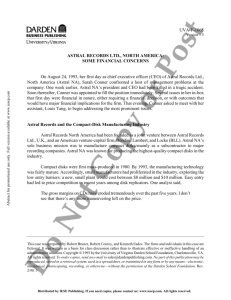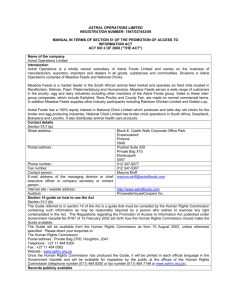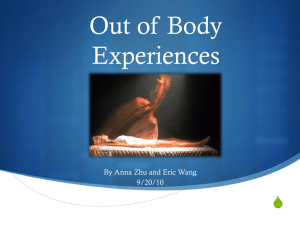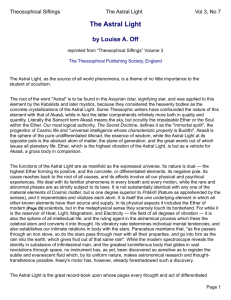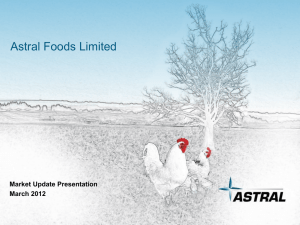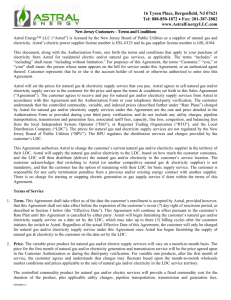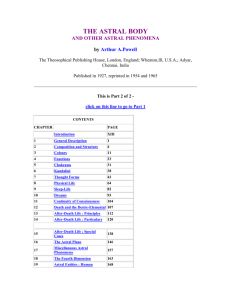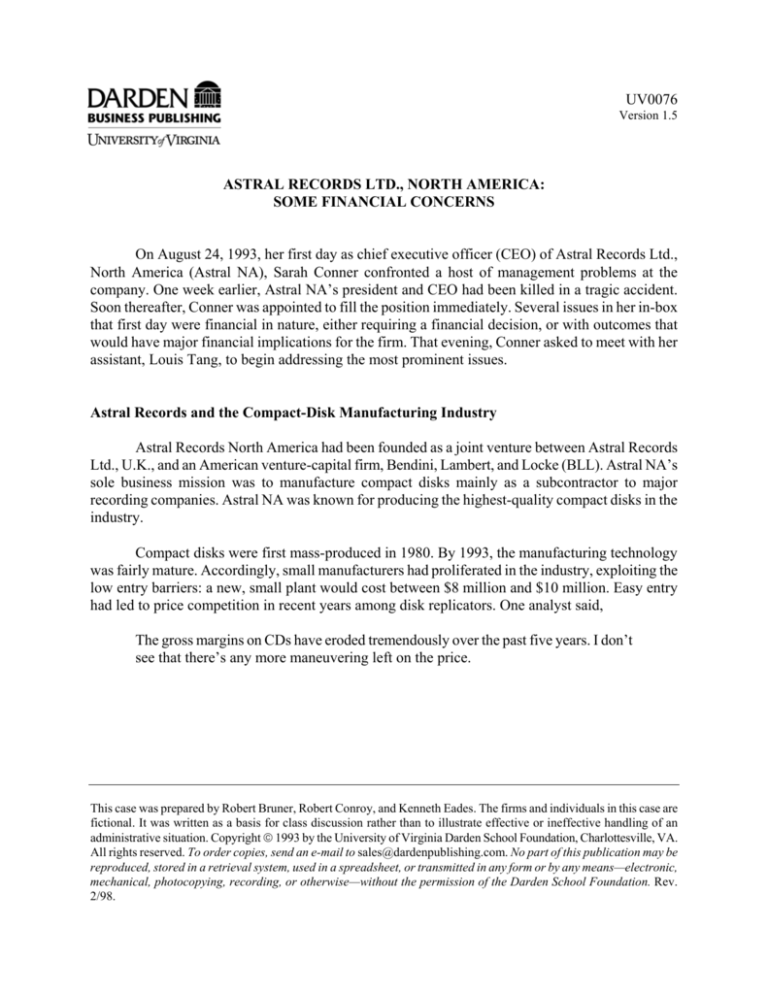
UV0076
Version 1.5
ASTRAL RECORDS LTD., NORTH AMERICA:
SOME FINANCIAL CONCERNS
On August 24, 1993, her first day as chief executive officer (CEO) of Astral Records Ltd.,
North America (Astral NA), Sarah Conner confronted a host of management problems at the
company. One week earlier, Astral NA’s president and CEO had been killed in a tragic accident.
Soon thereafter, Conner was appointed to fill the position immediately. Several issues in her in-box
that first day were financial in nature, either requiring a financial decision, or with outcomes that
would have major financial implications for the firm. That evening, Conner asked to meet with her
assistant, Louis Tang, to begin addressing the most prominent issues.
Astral Records and the Compact-Disk Manufacturing Industry
Astral Records North America had been founded as a joint venture between Astral Records
Ltd., U.K., and an American venture-capital firm, Bendini, Lambert, and Locke (BLL). Astral NA’s
sole business mission was to manufacture compact disks mainly as a subcontractor to major
recording companies. Astral NA was known for producing the highest-quality compact disks in the
industry.
Compact disks were first mass-produced in 1980. By 1993, the manufacturing technology
was fairly mature. Accordingly, small manufacturers had proliferated in the industry, exploiting the
low entry barriers: a new, small plant would cost between $8 million and $10 million. Easy entry
had led to price competition in recent years among disk replicators. One analyst said,
The gross margins on CDs have eroded tremendously over the past five years. I don’t
see that there’s any more maneuvering left on the price.
This case was prepared by Robert Bruner, Robert Conroy, and Kenneth Eades. The firms and individuals in this case are
fictional. It was written as a basis for class discussion rather than to illustrate effective or ineffective handling of an
administrative situation. Copyright © 1993 by the University of Virginia Darden School Foundation, Charlottesville, VA.
All rights reserved. To order copies, send an e-mail to sales@dardenpublishing.com. No part of this publication may be
reproduced, stored in a retrieval system, used in a spreadsheet, or transmitted in any form or by any means—electronic,
mechanical, photocopying, recording, or otherwise—without the permission of the Darden School Foundation. Rev.
2/98.
-2-
UV0076
Financial Questions Facing Sarah Conner
That evening, Conner met with Louis Tang, a promising new associate whom she had
brought along from BLL. Conner’s brief discussion with Tang went as follows:
Conner:
Back at BLL we looked at Astral as one of our most promising venture-capital
investments. Now it seems that such optimism may not be warranted—at least until
we get a solid understanding of the firm’s past performance and its forecasted
performance. Did you have any success with this?
Tang:
Yes, the bookkeeper gave me these: the historical-income statements (Exhibit 1) and
balance sheets (Exhibit 2) for the last four years. The accounting system here is still
pretty primitive. However, I checked a number of the accounts, and they look
orderly. So I suspect that we can work with these figures. From those statements, I
calculated a set of diagnostic ratios (Exhibit 3).
Conner:
I see that you have been busy. Unfortunately, I can’t study them right now. I need
you to review the historical performance of Astral NA for me, and to give me any
positive or negative insights that you think are significant.
Tang:
When do you need this?
Conner:
At 7:00 a.m. tomorrow. I want to call on our banker tomorrow morning to get an
extension on Astral’s loan.
Tang:
The banker, Farmington, said that Astral was “growing beyond its financial
capabilities.” What does that mean?
Conner:
It probably means that he doesn’t think we can repay the loan within a reasonable
period. I would like you to build a simple financial forecast of our performance for
the next two years (ignore seasonal effects) and show me what our debt requirements
will be at the fiscal years-ended 1994 and 1995. I think it is reasonable to expect that
Astral’s sales will grow at 15% each year. Use whatever assumptions seem
appropriate to you based on your historical analysis of the results. For this forecast,
you should assume that any external funding is in the form of debt.
Tang:
But what if the forecasts show that Astral cannot repay the loan?
Conner:
Then we’ll have to go back to Astral NA’s owners, BLL and Astral Records U.K.,1
for an injection of equity. Of course, BLL would rather not invest more funds unless
we can show that the returns on such an investment would be very attractive, and/or
1
Bendini, Lambert, and Locke owned a 60% interest in the equity of Astral NA. Astral Records Ltd., U.K., owned
the remaining 40% interest.
-3-
UV0076
that the survival of the company depends upon it. Thus, my third request is for you to
examine what returns on book assets and book equity Astral NA will offer in the next
two years and to identify the key driver assumptions of those returns. Finally, let me
have your recommendations about operating and financial changes I should make
based on the historical analysis and the forecasts.
Tang:
The plant manager revised his request for a new packaging machine and thinks that
these are the right numbers (see the plant manager’s memorandum in Exhibit 4).
Essentially, the issue is whether to invest now or to wait three years to buy the new
packaging equipment. The new equipment can save significantly on labor costs, but
carries a price tag of $1 million. My hunch is that our preference between investing
now versus waiting three years will hinge on the discount rate.
Conner:
[laughing] The joke in business school was that the discount rate was always 10%.
Tang:
That’s not what my business school taught me! BLL always uses a 40% discount rate
to value equity investments in risky start-up companies. But Astral is reasonably well
established now and shouldn’t require such a high-risk premium. I managed to pull
together some data (Exhibit 5) on comparable companies with which to estimate the
required rate of return on equity.
Conner:
Fine. Please estimate Astral’s weighted-average cost of capital (WACC) and assess
the packaging-machine investment. I would like the results of your analysis
tomorrow morning at 7:00 a.m.
3,715
(1,647)
2,068
1,000
$1,068
8 Earnings before taxes
9 Income taxes
10 Net earnings
Dividends on:
11 Dividends to all common shares
12 Retentions of earnings
1,000
$1,729
4,574
(1,845)
2,729
7,109
(2,535)
13,380
5,967
2,367
(21,714)
11,950
5,734
2,376
(20,060)
6,142
(2,427)
$28,822
1991
(actual)
$26,202
6 Operating margin
7 Interest expense
1 Sales
Operating expenses:
2 Production costs and expenses
3 Admin. and selling expenses
4 Depreciation
5 Total operating expenses
1990
(actual)
Historical Income Statements
(fiscal year ended August 23; all figures in thousands of dollars)
1,000
$ 943
3,212
(1,269)
1,943
6,476
(3,265)
17,847
7,020
2,667
(27,534)
$34,010
1992
(actual)
ASTRAL RECORDS LTD., NORTH AMERICA: SOME FINANCIAL CONCERNS
Exhibit 1
-4-
1,000
$1,195
3,598
(1,403)
2,195
6,820
(3,222)
22,335
7,970
2,667
(32,972)
$39,792
1993
(actual)
UV0076
12,060
4,511
9,014
25,585
10,000
11,315
$46,900
Liabilities and stockholders’ Equity:
Short-term borrowings (bank)1
Accounts payable
Other current liabilities
Total current liabilities
Long-term debt2
Shareholders’ equity
Total liabilities & stockholders’ equity
9
10
11
12
13
14
15
13,042
4,607
9,414
27,063
10,000
13,044
$50,107
$2,040
9,125
17,147
28,312
26,667
(4,872)
21,795
50,107
1991
(actual)
19,680
4,705
9,616
34,001
10,000
13,987
$57,988
$2,905
10,311
25,643
38,859
26,667
(7,538)
19,129
57,988
1992
(actual)
25,802
5,328
9,723
40,853
10,000
15,182
$66,035
$1,540
13,316
34,717
49,573
26,667
(10,205)
16,462
66,035
1993
(actual)
UV0076
Short-term debt was borrowed from Yurbank at an interest rate equal to LIBOR + 1%. LIBOR (London Interbank Offered Rate) was a common benchmark for
expressing the floating rate of interest on bank loans.
2
The company’s long-term debt of $10 million had been issued privately in 1989 to Bendini, Lambert, and Locke and to Astral Records Ltd., U.K. This debt was
subordinate to any bank debt outstanding.
1
$1,764
8,113
15,861
25,738
23,667
(2,505)
21,162
46,900
Assets:
Cash
Accounts receivable
Inventories
Total current assets
Gross property, plant, & equipment
Accumulated depreciation
Net property, plant, & equipment
Total assets
1
2
3
4
5
6
7
8
1990
(actual)
Historical Balance Sheets
(fiscal year ended August 23; all figures in thousands of dollars)
ASTRAL RECORDS LTD., NORTH AMERICA: SOME FINANCIAL CONCERNS
Exhibit 2
-5-
-6-
UV0076
Exhibit 3
ASTRAL RECORDS LTD., NORTH AMERICA:
SOME FINANCIAL CONCERNS
Ratio Analyses of Historical Financial Statements
(fiscal year ended August 23)
Profitability:
1
Operating profit margin
2
Average tax rate
3
Return on sales
4
Return on equity
5
Return on assets
Leverage:
6
Debt/equity ratio
7
Debt/total assets
8
EBIT/interest (×)
Asset utilization:
9
Sales/assets
10
Sales growth rate
11
Assets growth rate
12
Days in receivables
13
Payables to COGS
14
Inventories to COGS
Liquidity:
15
Current ratio
16
Quick ratio
1990
(actual)
1991
(actual)
1992
(actual)
1993
(actual)
23.4%
44.3%
7.9%
18.3%
4.4%
24.7%
40.3%
9.5%
20.9%
5.4%
19.0%
39.5%
5.7%
13.9%
3.4%
17.1%
39.0%
5.5%
14.5%
3.3%
1.95
0.47
2.53
1.77
0.46
2.80
2.12
0.51
1.98
2.36
0.54
2.12
55.9%
4.0%
6.0%
113.0
17.2%
60.5%
57.5%
10.0%
6.8%
115.6
16.0%
59.5%
58.7%
18.0%
15.7%
110.7
13.8%
75.4%
60.3%
17.0%
13.9%
122.1
13.4%
87.2%
1.01
0.39
1.05
0.41
1.14
0.39
1.21
0.36
-7-
UV0076
Exhibit 4
ASTRAL RECORDS LTD., NORTH AMERICA:
SOME FINANCIAL CONCERNS
O’Rourke’s Memo re: New Packaging Equipment
MEMORANDUM
TO:
Sarah Conner, President and CEO, Astral Records
FROM: Harvey O’Rourke, Plant Manager
DATE: August 24, 1993
SUBJECT: New Packaging Equipment
Although our CD packaging equipment is adequate at current production levels, it is terribly inefficient. The new
machinery on the market can give us significant labor savings as well as increased flexibility with respect to the type of
packaging used. I recommend that we go with the new technology. The considerations relevant to the decision are
included in this memo.
Our current packaging equipment was purchased five years ago as used equipment in a liquidation sale of a small
company. Although the equipment was inexpensive, it is slow, requires constant monitoring, and is frequently down for
repairs. Since the packaging equipment is significantly slower than the production equipment, we routinely have to use
overtime labor to allow packaging to catch up with production. When the packager is down for repairs, the problem is
exacerbated and we may spend several two-shift days catching up with production. I cannot say that we have missed any
deadlines because of packaging problems, but it is a constant concern around here and things would run a lot smoother
with more reliable equipment. In 1994, we will pay about $5,000 per year for maintenance costs. The operator is paid
$30,000 per year for his regular time, but he has been averaging $40,000 per year because of the overtime he has been
working. The equipment is on the tax and reporting books at $100,000 and will be fully depreciated in three years’ time
(we are currently using the straight-line depreciation method for both tax and reporting purposes and will continue to do
so). Because of changes in packaging technology, the equipment has no market value other than its worth as scrap metal.
But its scrap value is about equal to the cost of having it removed. In short, we believe the equipment has no salvage
value at all.
The new packager offers many advantages over the current equipment. It is faster, more reliable, more flexible with
respect to the types of packaging it can perform, and will provide enough capacity to cover all our packaging needs in the
foreseeable future. With suitable maintenance, we believe the packager will operate indefinitely. Thus, for the purposes
of our analysis, we can assume that this will be the last packaging equipment we will ever have to purchase. Because of
the anticipated growth at Astral, the current equipment will not be able to handle our packaging needs by the end of 1996.
Thus, if we do not buy new packaging equipment by this year’s end, we will have to buy it after three years’ time
anyway. Since the speed, capacity, and reliability of the new equipment will eliminate the need for overtime labor, we
feel strongly that we should buy now rather than wait another three years.
The new equipment currently costs $1 million, which we would depreciate over 10 years at $100,000 per year. It comes
with a life-time factory maintenance contract that covers all routine maintenance and repairs at a price of $2,000 for the
initial year. The contract stipulates that the price after the first year will be increased by the same percentage as the rate
of increase of the price of new equipment. Thus, if the manufacturer continues to increase the price of new packaging
equipment at 5% per annum as it has in the past, our maintenance costs will rise by 5% also. We believe that this sort of
regular maintenance should insure that the new equipment will keep operating in the foreseeable future without the need
for a major overhaul.
Astral’s labor and maintenance costs will continue to rise due to inflation at approximately 5% per year over the long
term. Because the manufacturer of the packaging equipment has been increasing its prices at about 5% per year, we can
expect to save $157,625 in the purchase price by buying now rather than waiting three years. The marginal tax rate for
this investment would be 40%.
95%
90%
40%
60%
Harris-Beshel
Donaldson, Inc.
IBBEX Corp.
ZEPORT
8
9
1-year
3-year
5-year
10-year
30-year
U.S. Treasury bills
U.S. Treasury bills
U.S. Treasury bills
U.S. Treasury bonds
U.S. Treasury bonds
Source: Case writers’ estimates.
2.8%
3-month
U.S. Treasury bills
6.2%
6.0%
5.1%
4.6%
3.0%
5.0%
LIBOR
10
16
12
Price/
Earnings
Ratio
Recently Issued Bonds (as of 8/24/93)
20%
Dickenson, Inc.
Name
Percentage
of Sales
from CD
Production
Beta
1.60
1.45
1.20
1.30
1.50
ZEPORT
IBBEX Corp.
Donaldson, Inc.
Harris-Beshel
$25.00
16.80
5.25
12.75
$ 5.50
Book Value
per Share
Dickenson ,Inc.
1.30
0.10
1.40
0.70
0.45
Book
D/E
9.0%
8.0%
8%
7%
7.2%
Coupon
$40.00
20.00
18.00
14.00
$10.00
Market
Price
per Share
2008
2003
2008
2013
1998
Price
$100.00
100.00
109.20
100.00
8
6
4
7
10
Analysts’
5-Year
Earnings Growth
Forecast (%)
$102.95
$2.20
0.00
0.75
1.00
$0.95
Last Annual
Dividend
per Share
Maturity
10.0
15.0
10.0
7.5
5.0
Number of
Shares
Outstanding
(Millions)
Data on Comparable Companies and Capital-Market Conditions
ASTRAL RECORDS LTD., NORTH AMERICA: SOME FINANCIAL CONCERNS
Exhibit 5
-8-
B
Baa
AA
AA
A
Rating
B
Baa
AA
AA
A
Bond
Rating
UV0076
-9-
UV0076
Exhibit 5 (continued)
Description of companies:
Dickenson, Inc.
This company was founded 50 years ago in Detroit. Its major business
activities historically have been the production of original artist recordings,
management and production of rock-and-roll road tours, and personal
management of artists. It only recently has entered the CD production market.
Harris-Beshel
This company was a spin-off from a large conglomerate in 1978. Although the
company was a leader in the production of CDS, it recently suffered a decline
in sales. Infighting among the principal owners has fed concerns about the
firm’s prospects.
Donaldson, Inc.
This company, founded only two years ago, has emerged as a very aggressive
competitor in the area of CD production. It is Astral’s major competitor and its
sales level is about the same.
IBBEX Corp.
This company has recently been an innovator in the production of CDs.
Although CD manufacturing is not a majority of its business (film production
is its main focus), the company is projected to be a major competitor within the
next three years.
ZEPORT
This company was an early pioneer in the CD industry. Recently, however, it
began to invest in new areas and has been moving away from CD production as
its main focus of business.

